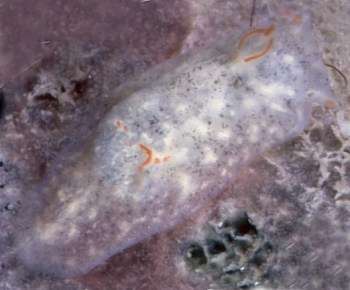
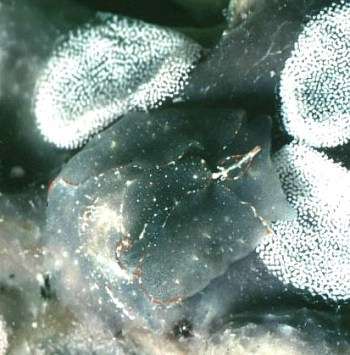
Sagaminopteron nigropunctatum
Carlson & Hoff, 1973
Order: CEPHALASPIDEA
Superfamily: PHILINOIDEA
Family: Gastropteridae
DISTRIBUTION
Possibly widespread in the western Pacific. Records from Guam, Rota (Northern Marianas), Palau, and Cabilao in the Philippines. (See Carlson & Hoff message below.
PHOTO
UPPER: 5.5 mm; Guam, Cocos reef, 8m; 27 September 1970,
On Dysidea granulosa
LOWER: 8.0mm; Palau, Wonder Channel, 13m; 24 September 1996, On Dysidea granulosa with egg masses.
PHOTOS: C. Carlson & P.J.Hoff.
Sagaminopteron nigropunctatum is well camouflaged on the grey sponge on which it is usually found, the colouring and texture being almost identical. It is a translucent greyish with fine black specks and light grey to cream coloured pustules, the upper photo showing a 'typical' example. There is some variation in the background colour with some animals appearing translucent cream, and the black speckling varies from dense to very sparse in different animals. The edges of the siphon are usually orange, and sometimes the tip of the siphon as well. There are two distinctive orange spots on the headshield, one at each anterior corner, and the flagellum is also often edged with orange. In different specimens varying numbers of other orange specks can be found.
It is always found associated with a species of the sponge Dysidea and compared with other gastropterids, S. nigropunctatum is reported to be rather 'sluggish' seldom seen to swim.
Reference:
• Carlson, C.H. & Hoff, P.J. (1973). Two new species of Gastropteridae from Guam, Marianas Islands (Opisthobranchia: Cephalaspidea). Publications of the Seto Marine Biological Laboratory, 21(2): 141-151.
See Carlson & Hoff message for further photos.
Authorship detailsRudman, W.B., 1999 (August 5) Sagaminopteron nigropunctatum Carlson & Hoff, 1973. [In] Sea Slug Forum. Australian Museum, Sydney. Available from http://www.seaslugforum.net/find/saganigr
Related messages
Sagaminopteron nigropunctatum from Reunion Island
May 4, 2010
From: Philibert Bidgrain
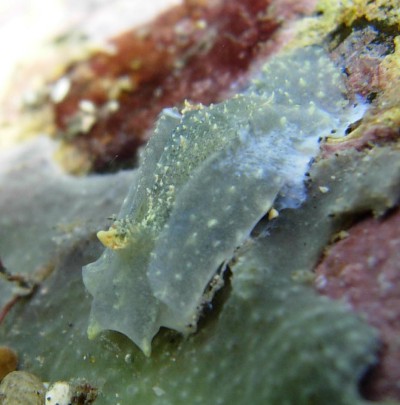
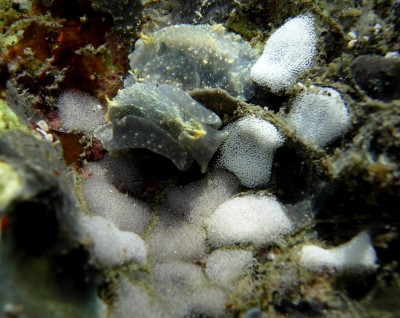
Dear Bill,
We found some specimens of this species, it looks like some photo of Sagaminopteron nigropunctatum
Locality: Etang Salé, less 1 m, Reunion Island, Indian Ocean, October 2009. Length: 15 mm. Photographer: Christophe Cadet.
What's your opinion ?
All the bests
Philibert Bidgrain
http://seaslugs.free.fr/
pbidgrain@yahoo.fr
Bidgrain, P., 2010 (May 4) Sagaminopteron nigropunctatum from Reunion Island. [Message in] Sea Slug Forum. Australian Museum, Sydney. Available from http://www.seaslugforum.net/find/23592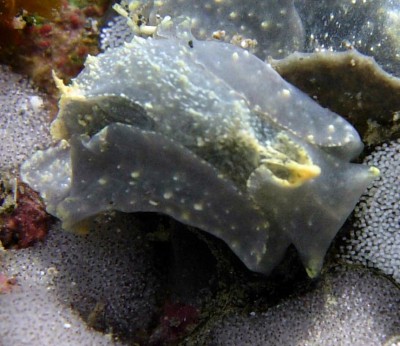
Dear Philibert,
In shape and colour it certainly looks like that species. In their messages on the Forum, Carlson & Hoff note that in the western Pacific this species is usually found on species of the sponge genus Dysidea and are well camouflaged. I can't see enough detail to be sure of the identity of the sponge they are associated with in these photos, but whatever it is, the animals are well camouflaged.
Obviously without anatomical information we can't be 100% sure, but I would agree that it appears that S. nigropunctatum has a much wider distribution than previously thought. The photo with the multiple egg masses certainly reminds me of the photo on the species Fact Sheet.
I will be interested in Clay Carlson's comments.
Best wishes,
Bill Rudman
Sagaminopteron nigropunctatum
August 7, 1999
From: C.J. Carlson & P.J. Hoff
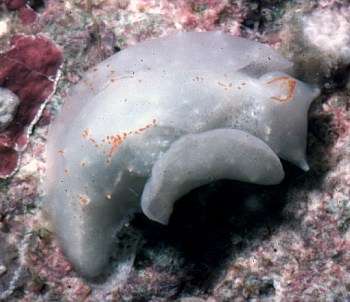
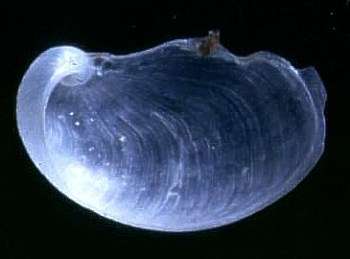
Bill,
Since you had a spate of Gastropteridae lately, we thought we would add one, Sagaminopteron nigropunctatum Carlson & Hoff, 1973, that most people haven't run into. We presently have records for this animal from Guam, Rota (Northern Marianas), Palau and Cabilao in the Philippines. It is probably fairly wide spread in at least the Western Pacific but can be difficult to see on its host sponge (I know you don't believe this) Dysidea granulosa Bergquist, 1965. Two specimens found in the Philippines were on Dysidea herbacea and were very pale.
UPPER PHOTO: 13.0mm; Philippines, Cabilao Is., 5m; 28 April 1997 found on Dysidea herbacea. LOWER PHOTO: S. nigropunctatum shell, from 12.5mm specimen; ventral view, approximate length 3.5mm
[See other photos Clay & Patty Jo sent at Top of Page.]
Clay & Patty Jo
Merizo, Guam.
clay.carlson@kuentos.guam.net
Carlson, C.J. & Hoff, P.J., 1999 (Aug 7) Sagaminopteron nigropunctatum. [Message in] Sea Slug Forum. Australian Museum, Sydney. Available from http://www.seaslugforum.net/find/1150Dear Clay & Patty Jo,
Thanks for the photos, including the shell and egg mass photos. With cryptic animals egg masses are often the first sign that something is there. I hope the more species we can illustrate on the Forum, the more eyes will be alerted to go and have a look.
Concerning the sponge story. I don't dispute that many species of gastropterid are found associated with particular sponges, much like many species of the nudibranch dorid Trapania are found associated with sponges. What I think we should be alert to is the possibility that the close association is not necessarily an indication that the sponge is their food. In both Sagaminopteron and Trapania their relatives are not sponge feeders and in both Sagaminopteron and Trapania their radular morphology is very similar to that of their relatives, suggesting that if they are eating the sponges, then they have evolved no radular modifications to do so.
Of course this is possible, but I think we should keep looking. It is of course not made any easier by the fact that species of Dysidea don't have a spicule based skeleton, so stomach contents are not going to be of great help.
Best wishes,
Bill Rudman.
